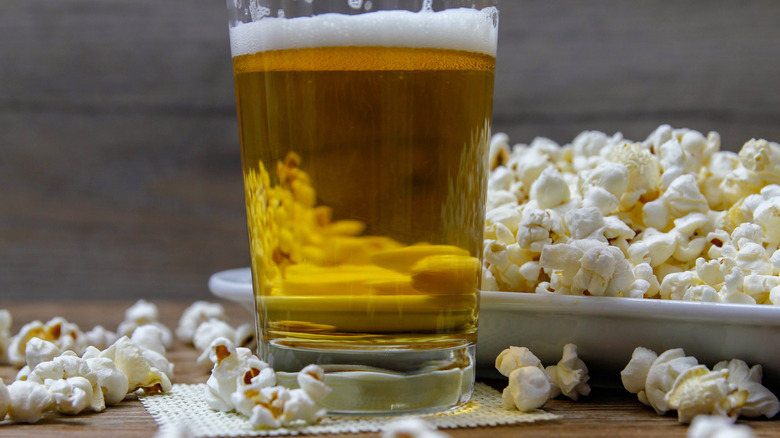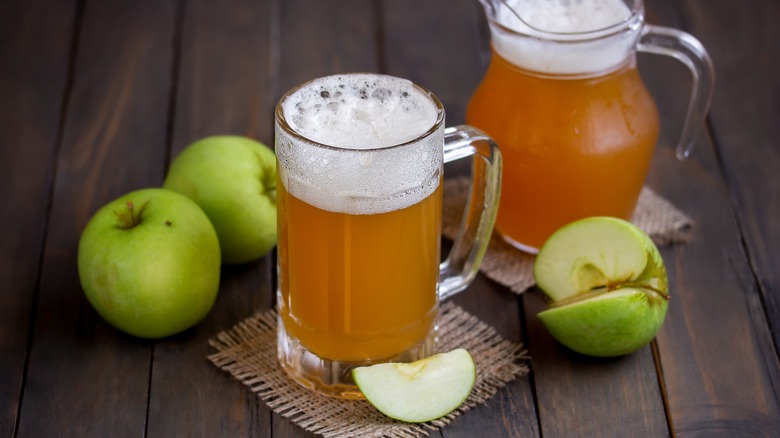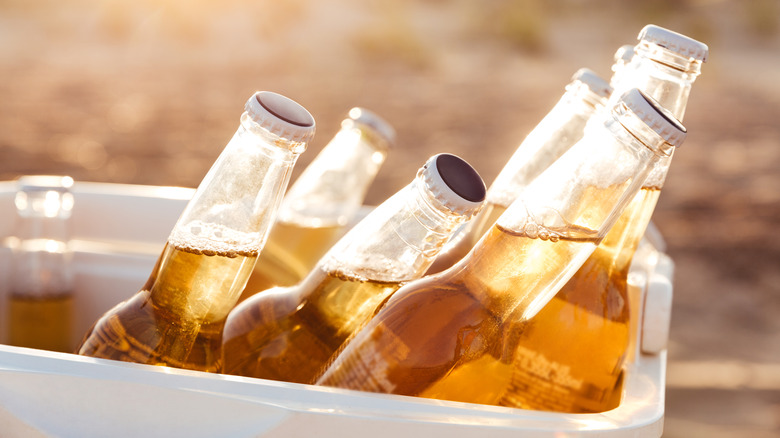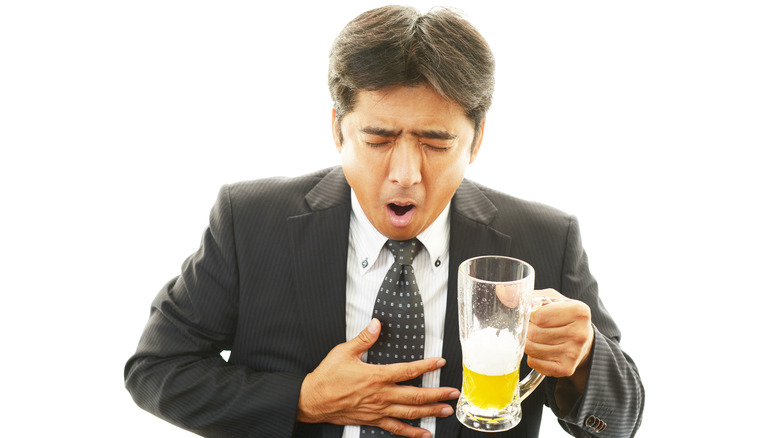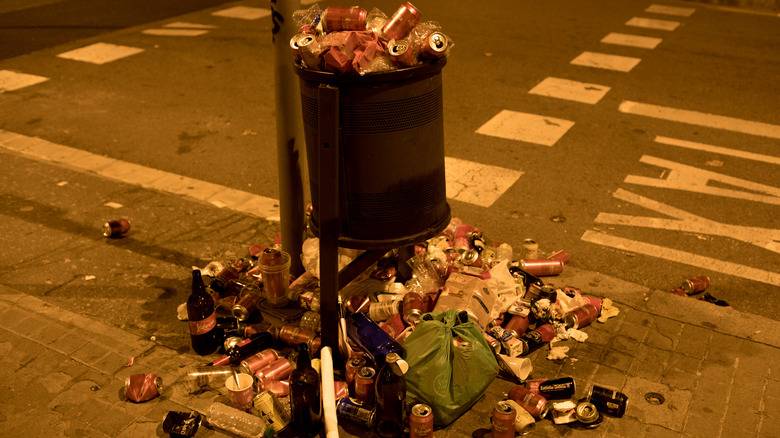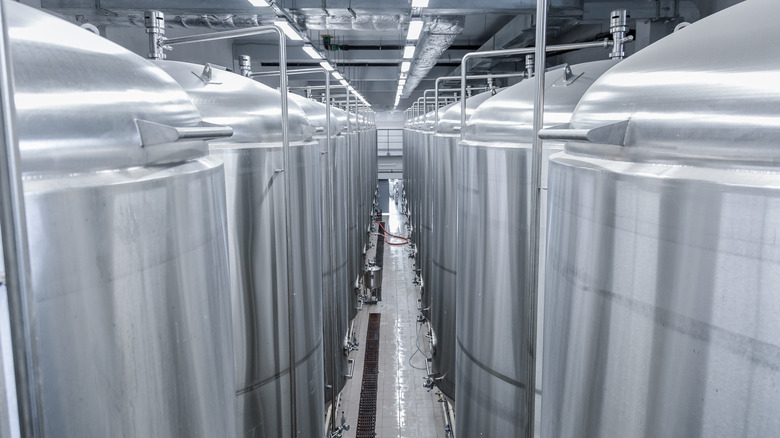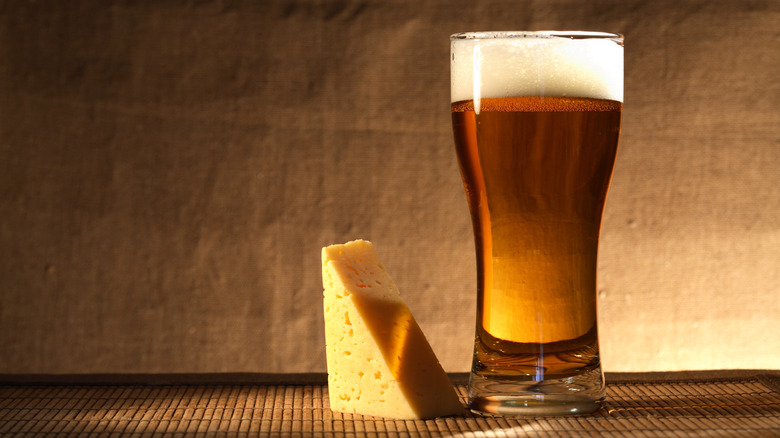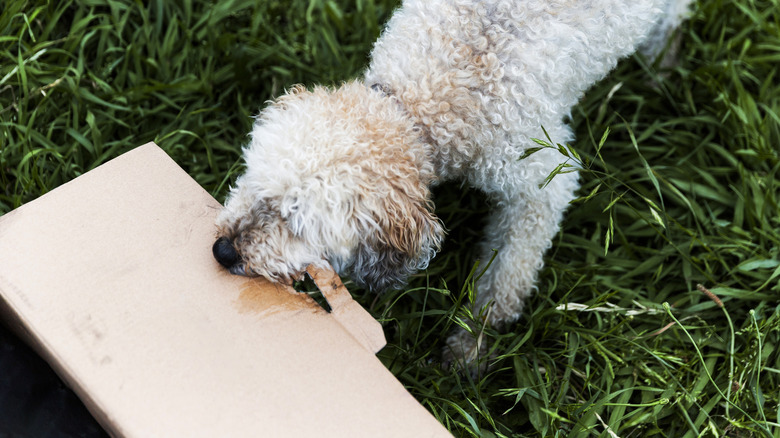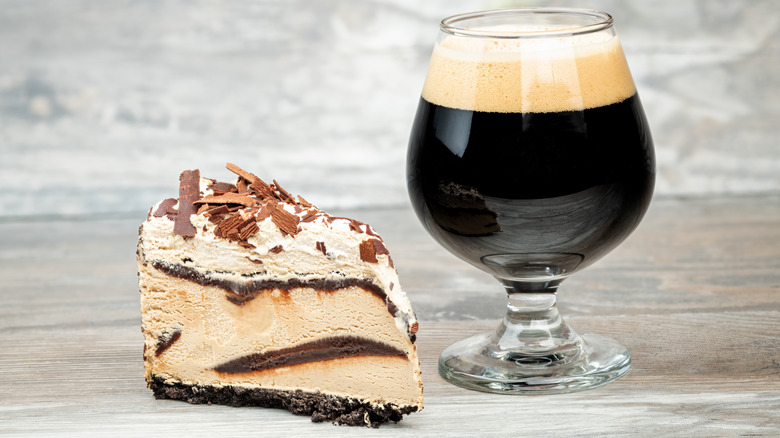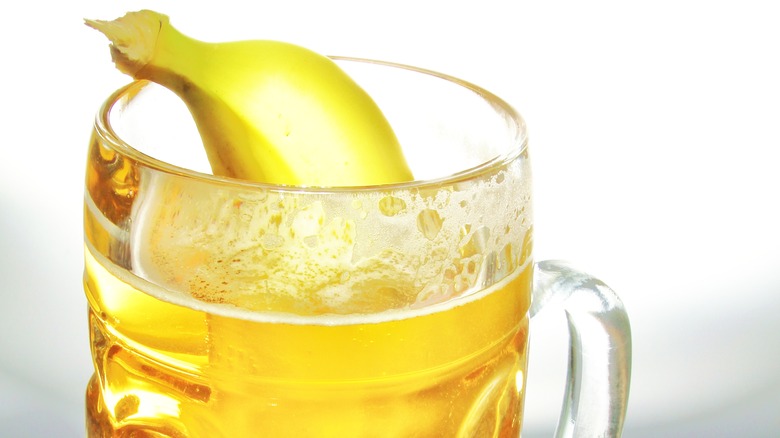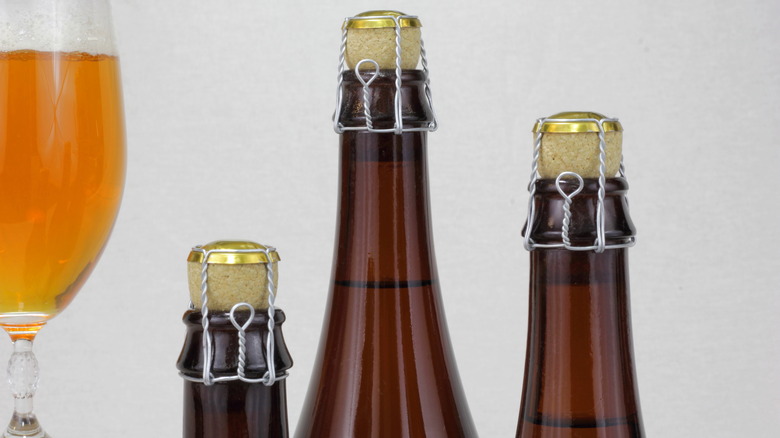14 Off-Flavors To Look Out For In Your Next Beer
It can be quite a surprise if something doesn't taste the way it's supposed to, whether we're talking about dinner leftovers, ice cream, or beer. And in the case of beer, there are a lot of ways the flavor can stray. According to "The Oxford Companion to Beer," its taste is affected by more than 1,400 compounds. If just one or two of them increase beyond the desired level, it may create "off-flavors" that significantly affect the result.
The taste being out of whack is more than just an inconvenience. Food Manufacture writes that, throughout the food industry, off-flavors lead to product recalls that damage the bottom line and a brand's reputation. For example, in 2019, Uinta Brewing had to recall 11 different beers because of off-flavors and aromas caused by foreign yeast contamination (via The Salt Lake Tribune).
As such, flavor problems are taken seriously in the brewing world. Brewer Magazine notes that many breweries have trained tasting panels to help detect problems before a batch hits store shelves. But you don't need to be a pro to know something is off. In this guide to beer off-flavors, we're examining some of the bad beer tastes to watch for as well as what causes them.
1. Diacetyl (buttered popcorn)
Beer and popcorn are a great combination for watching a movie. But if your beer tastes like popcorn, that's an off-flavor. The Beer Judge Certification Program (BJCP) describes diacetyl as a by-product from fermentation that is usually reduced by the yeast to safe levels. However, in certain circumstances, it can remain at high amounts that produce the taste and aroma of artificial butter. Diacetyl can also present as a butterscotch or toffee flavor while making your mouth feel slick.
So what causes an overabundance of diacetyl? Common reasons include separating the beer and yeast too early, excessive oxygen exposure, low nitrogen levels, and yeast mutation. Craft Beer & Brewing adds that bacteria also can create diacetyl through malolactic fermentation. Although some diacetyl may be desired in certain beer and wine (such as California Chardonnay), lager brewers take it so seriously that they often do a "diacetyl rest," in which they deliberately raise the temperature about 10 degrees Fahrenheit to help the yeast break this compound down.
2. Acetaldehyde (green apple)
Unless it's a beer you specifically want to taste like an apple, then excessive acetaldehyde is a flavor note to avoid. White Labs says this compound is a by-product formed by yeast. Acetaldehyde is everywhere during early fermentation, but in most cases, it eventually changes to ethanol. Asian Beer Network claims low levels of acetaldehyde can make a beer taste fresh and crisp, which is why Budweiser has small amounts.
However, if the compound reaches levels of even five to 10 parts per million, it can lead to an aroma of green apple or pumpkin rind. The most common reason for this off-flavor is that the beer was rushed to your refrigerator before maturing. Poor yeast health, yeast being used for too long, oxidation, and improper zinc levels can also cause acetaldehyde to not convert or to be reintroduced.
Whatever the reason for it, White Labs lists acetaldehyde as "usually undesirable" — and that may be generous. In a comparative study published in the Archives of Industrial Hygiene and Toxicology, researchers found acetaldehyde was far more toxic than ethanol in rats to the point of significantly inhibiting cell viability. Talk about an apple a day not keeping the doctor away.
3. Light-struck (skunky)
If you've ever taken a sip of a beer and immediately thought, "that tastes like a skunk smells," that assessment might not be far off. First scientifically reported in 1875, the "light-struck flavor" is a longstanding challenge for brewers (via Cerevisia). And in 2001, we learned what causes it. Science Daily details that researchers from the University of North Carolina at Chapel Hill found that light exposure eventually causes isohumulones in the hops to break down. This creates a compound called 3-methylbut-2-ene-1-thiol (MBT) — known colloquially as "skunky thiol" because MBT's odor is so similar to that of skunk spray.
But even before this discovery, many brewers had learned how to combat light-struck beer. LiveScience notes that beer is typically stored in special containers to block light. Kegs and aluminum cans stop all light, while brown glass does an excellent job (via Wired). Other companies use green glass, which offers some protection but not as much. Per Insider, the main reason green bottles are popular is that brown glass was in short supply post-World War II and brewers needed a substitute. Finally, some modern brewers add a light-blocking coating to clear glass, though you will need to research whether they do before purchasing.
4. Butyric acid (vomit)
Who wants to drink something that smells and tastes like barf? Not someone expecting a delicious brew, that's for sure. While this compound is used in many foods, too much of it creates a sickly taste (via the Journal of the American Society of Brewing Chemists (JASBC)). Oculyze adds that it's found in a lot of places naturally, including plant oils and animal fat. Your digestive system also creates it when breaking down fiber, hence the vomit flavor. The detection threshold is only 240 parts per billion, so not a lot is needed (via Leffingwell & Associates).
But what makes your beer tastes like puke — and maybe makes you want to puke? Clostridium bacterial infections of the sugar syrup during production is the main reason for a high butyric acid concentration (via the JASBC). Distiller Magazine observes it can also happen due to dirty fermentation or artificially adding acid before the yeast. Incidentally, if ethanol binds to the butyric acid, it creates the smell of pineapple — which is technically still an off-flavor but is far more palatable to most people than someone throwing up their lunch.
5. Mercaptan (rotten garbage)
We think you'll agree that garbage doesn't smell good anywhere — but especially when the smell is coming from your beer. This utterly rotten beer off-flavor is because of mercaptan, which the Master Brewers Association of the Americas notes is an especially noisome sulfur compound. The Siebel Institute of Technology points out that this same compound is added to propane and natural gas so people can detect them. That's how much it stinks.
Also known by its chemical name of ethanethiol or ethyl mercaptan, the New Jersey Department of Health and Senior Services adds that it might present as a skunk or garlic smell. More seriously, mercaptan can be toxic in any form, with potential side effects that include throat irritation, headaches, dizziness, and liver or kidney damage.
How in the world does mercaptan end up in beer? Common causes are yeast autolysis, yeast stress, bacterial contamination, and dry-hopping — which Sierra Nevada Brewing Co. says is when you add hops later than normal. To prevent beer from smelling rotten, Small Batch Brew Co. says home brewers should use the correct yeast for the beer they're making, keep equipment sanitized, and not let beer spend more than four weeks on the yeast cake.
6. Hydrogen sulfide (rotten eggs)
We can see having some fried or scrambled eggs with a beer. Rotten eggs, though, are another matter. This beer off-flavor to watch for is a result of high hydrogen sulfide (H2S) levels (via Lallemand). Although low quantities of H2S add character to lagers, English pale ales, and other classic beer styles, too much will lead to the distinct whiff of rancid eggs.
It's no surprise given the compound's rotten origins. Per the Occupational Safety and Health Administration, H2S is found naturally in places such as manure pits, oil wells, and sewers. It's also highly toxic and flammable, causing symptoms such as headaches and eye irritation even at low loads.
Lallemand notes that several factors affect the production of hydrogen sulfide in beer, including the yeast strain, the fermentation temperature, and how the yeast is handled. It can also be produced during packaging by oxygen stimulating the yeast. Ironically, the switch from copper to stainless steel brewing equipment may be contributing to the rise of H2S, as it's been found that copper ions convert it to copper sulfide that falls harmlessly away. Hydrogen sulfide is such a concern that, in 2013, Arizona Instrument LLC introduced new technology to help detect high levels (via WaterWorld).
7. Metallic (bitter)
Metal music and beer go together — just witness the annual Metal & Beer Fest by Decibel Magazine. But it's a problem when the metal is in your cup. There are many reasons why beer can have a bitter, metallic taste. The ASBC notes that several compounds cause metallic flavor — and a very low concentration is needed. Ss Brewtech says unhealthy or stressed yeast can create a metallic essence by releasing certain minerals. More often, though, it either comes from materials leaching metal ions during the brewing process or using unfiltered water (via Craft Beer & Brewing).
Therefore, the equipment and water source are what should be addressed first. Stainless steel has become popular in brewing because it is better at resisting corrosion — which means fewer ions are released (via Technical Quarterly). Some people think drinking beer from cans causes a metallic taste. However, Master Cicerone Pat Fahey tells WRTV Indianapolis that cans are lined to prevent contamination, and the source of this metallic off-flavor is more likely the smell of the can's surface. So if you pour a can of beer into a glass and it still tastes like metal, that's when you know the wrong kind of concert is on stage.
8. Dimethyl sulfide (vegetables)
If you want your adult beverage to smell and taste like veggies, we have the beer off-flavor for you. Dimethyl sulfide (DMS) is a positive contributor to a lager's flavor profile in small quantities (via the Italian Journal of Food Science). But more than 100 micrograms per liter can produce a vegetable-like flavor and smell. Scott Janish notes that various literature has described the DMS flavor profile as resembling cabbage, canned corn, rotten onions, black olives, and sauerkraut. DMS is also found naturally in some sea microbes, leading to the description "the smell of the seaside" (via ScienceDaily).
But for those who don't want a beer with a waft of a boiled dinner or the nearest seacoast, it's important to control the DMS levels. A study in Brewing Science notes that DMS is produced either by the decomposition of S-methyl methionine (SMM) during the malting process or by the yeast reducing dimethyl sulfoxide (DMSO). Most DMS usually evaporates during the boil and isn't an issue. However, if there's a lot of SMM or DMSO in the initial malt, there will be more DMS in the final product. DMS forms much faster at temperatures above 176 degrees — so keep your cool while fermenting.
9. Isovaleric acid (cheesy)
Pairing beer and cheese is a common practice. There's even "beer cheese," a cheese spread developed to get people to drink more beer (via Howard's Creek). But the smell of cheese in your beer is another story — and there are a few reasons it can happen. A research review published in Beverages states that isovaleric acid usually forms due to the oxidation of alpha acids when using hops. It also can be caused by an infection from the Brettanomyces yeast genus (via Beer Sensory Science). Finally, a study written up in the Journal of the Science of Food and Agriculture found that the mashing process can play a role in the development of isovaleric acid.
Whatever the explanation, even 1 milligram per liter of this short-chain fatty acid can lead to an old cheese aroma. Isovaleric acid — which is in the same family as butyric acid, another common beer off-flavor — may also declare itself as dirty socks or sweat smells. This is less surprising, though no less disgusting, when you know that isovaleric acid is also the sensory agent in foot odor (via the Canadian Journal of Microbiology). Using fresh hops that are stored away from oxygen and keeping your brewing equipment clean are the best ways to avoid producing cheesy-feet beer.
10. Oxidation (cardboard or paper)
We think you'll agree that cardboard is for packaging beer, not what it should taste like. Although some oxygen is needed during the brewing process, Brau Supply reminds us that too much will cause problems. Specifically, the development of trans-2-nonenal is what causes the taste of cardboard, wet paper, or general staleness (via the Home Brewer's Association). This compound comes from the oxidation of lipids and free fatty acids such as the linoleic acid found in malted barley. And with a flavor threshold of just 0.1 parts per billion, it barely takes any to be drinking papery beer.
Oxidation during the brewing process most often happens when the beer is being transferred between containers, such as when you pour it into a bottling bucket or keg. But it also can occur at many other times. The Free Times adds that packaged beer will eventually oxidize, too, especially at warm temperatures. Oxidation is especially a problem in craft beers — since small breweries typically use less advanced equipment, the final product often contains more oxygen and thus ages poorly. This is one of many reasons why you should pay attention to the bottling date or best-by date on your beer.
11. Overly sweet
A little sweetness is fine and even desirable in certain beers. At the same time, you don't necessarily want your beer to taste like sugar syrup. HowStuffWorks writes that beer is created by fermentation wherein yeast converts glucose, a simple sugar, into alcohol and carbon dioxide. In most cases, the goal is to use up nearly all the sugar so that the beer will be crisp and the taste doesn't hang around (via Allagash Brewing Company). If too many sugars are left in the beer, it will taste extremely sweet with a wet mouthfeel that lingers and lingers.
If your beer hits your mouth sweet and the sweetness stays, it's usually due to a brewing problem leaving residual sugars. Adventures in Homebrewing lists some of the potential issues as incomplete fermentation, a low-quality yeast strain that doesn't convert enough sugar, or mashing at too high a temperature. Other reasons a beer might be sugary are that the brewer didn't use enough hops, used certain sweet malts and complex sugars, or boiled the mixture for too long. Finding the right balance gives you the body and flavor you want without feeling like you're drinking dessert.
12. Isoamyl acetate (bananas)
Though you might want a fruity character in certain beers, a standard lager shouldn't be smelling like bananas. If it does, there's an isoamyl acetate problem on your palate. Per an article in the journal Alcoholic Beverages, isoamyl acetate is a type of ester which is used to add flavor in everything from jelly to candy. This chemical compound is even used in fragrances and air fresheners to give them a banana- or pear-like note (via Chemoxy).
Still, if you open a beer and are greeted with a banana perfume smell, there's a good chance something went wrong. Isoamyl acetate is produced by yeast and thus plays a role in the flavor profile of all beers. However, it's usually at a level of around 1.4 milligrams per liter. When esters synthesize beyond this amount, it typically has to do with either the wort composition and aeration or how the fermenting equipment is designed (via the Journal of Bioscience and Bioengineering). Stone Brewing adds that the reactions which create esters happen at higher temperatures, so top-forming yeast is most likely to make them. The good news is that isoamyl acetate is low toxicity, so the only things an excess quantity should affect are your taste buds and nose.
13. Trichloroanisole (musty)
The name of this beer off-flavor is hard to say — and the smell is even harder to forget. Also going by the name 2,4,6-trichloroanisole or simply TCA, it's a form of anisole that has been chlorinated (via CraftBeer.com). Trichloroanisole contamination is most widespread in the wine industry — so much so that it's sometimes called "cork taint" (via Chemistry World). But Avani Solutions comments that it's also found in beer, particularly if a beer line is put back into use after a long hiatus — and even minuscule amounts of TCA are perceptible.
TCA is the result of when airborne fungi and chlorophenols collide, producing a smell that brings musty buildings and moldy newspapers to mind. Cleaning equipment with chlorinated water is an almost surefire path to TCA contamination. Certain yeast strains and bacteria are also TCA sources. And finally, TCA can jump from packaging materials into beer or onto equipment. This is why TCA is such a problem with wine — the wood used to make corks often contains chlorophenols from pesticides or the sterilization process. So if you have beer or wine with a cork closure, Phoenix Magazine reminds you to do a "nose check" before drinking.
14. Astringency (excessively dry)
A little dryness or tartness in a beer is sometimes sought after. The issue is the times when taking a sip makes your mouth pucker up. According to "The Oxford Companion to Beer," astringency comes from phenols that originate in sources such as malt husks and hop stems. During brewing and maturation, they become polyphenols — most notably tannins that cause the mouth-puckering effect. It's like drinking a strong cup of tea.
Some astringency is good for balance, but a lot makes a beer so dry and harsh that it's uncomfortable to drink. The most frequent reason for the astringency off-flavor is over-sparging — this is when one steeps the grain for too long or uses too much water, which releases more phenols (via Love2Brew). Other sources of astringency include too high a sparging temperature, high pH levels, or too many herbs and spices.
Part of the problem with detecting astringency is that, as noted by a research review written up in Beverages, untrained drinkers often confuse it with bitterness. A review published in Trends in Food Science & Technology offers this comparison: While bitter is a taste, astringency is more of a sensation. So if your mouth wants to draw into itself after a drink, that's a sign of an astringent beer.

